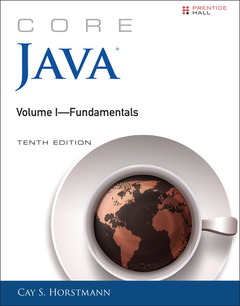Description
Core Java (10th Ed.)
Volume I : Fundamentals
Author: HORSTMANN Cay S.
Language: English
Subjects for Core Java:
Approximative price 75.92 €
In Print (Delivery period: 14 days).
Add to cart1007 p. · Paperback
Description
/li>Contents
/li>Biography
/li>
Core Java® has long been recognized as the leading, no-nonsense tutorial and reference for experienced programmers who want to write robust Java code for real-world applications. Now, Core Java®, Volume I—Fundamentals, Tenth Edition, has been extensively updated to reflect the most eagerly awaited and innovative version of Java in years: Java SE 8. Rewritten and reorganized to illuminate new Java SE 8 features, idioms, and best practices, it contains hundreds of example programs—all carefully crafted for easy understanding and practical applicability.
Writing for serious programmers solving real-world problems, Cay
Horstmann helps you achieve a deep understanding of the Java language
and library. In this first volume of the two-volume work, Horstmann
focuses on fundamental language concepts and the foundations of modern
user interface programming. You’ll find in-depth coverage of topics
ranging from Java object-oriented programming to generics, collections,
lambda expressions, Swing UI design, and the latest approaches to
concurrency and functional programming.
This guide will help you :
-
Leverage your existing programming knowledge to quickly master core Java
syntax
- Understand how encapsulation, classes, and inheritance work
in Java
- Master interfaces, inner classes, and lambda expressions
for functional programming
- Improve program robustness with
exception handling and effective debugging
- Write safer, more
readable programs with generics and strong typing
- Use pre-built
collections to collect multiple objects for later retrieval
- Master
concurrent programming techniques from the ground up
- Build modern
cross-platform GUIs with standard Swing components
- Deploy
configurable applications and applets, and deliver them across the
Internet
- Simplify concurrency and enhance performance with new
functional techniques
If you’re an experienced programmer moving
to Java SE 8, Core Java®, Tenth Edition, will be your
reliable, practical companion—now and for many years to come.
Acknowledgments
Chapter 1: An Introduction to Java
. 1.1 Java as a Programming Platform
. 1.2 The Java “White Paper” Buzzwords
. 1.3 Java Applets and the Internet
. 1.4 A Short History of Java
. 1.5 Common Misconceptions about Java
Chapter 2: The Java Programming Environment
. 2.1 Installing the Java Development Kit
. 2.2 Using the Command-Line Tools
. 2.3 Using an Integrated Development Environment
. 2.4 Running a Graphical Application
. 2.5 Building and Running Applets
Chapter 3: Fundamental Programming Structures in Java
. 3.1 A Simple Java Program
. 3.2 Comments
. 3.3 Data Types
. 3.4 Variables
. 3.5 Operators
. 3.6 Strings
. 3.7 Input and Output
. 3.8 Control Flow
. 3.9 Big Numbers
. 3.10 Arrays
Chapter 4: Objects and Classes
. 4.1 Introduction to Object-Oriented Programming
. 4.2 Using Predefined Classes
. 4.3 Defining Your Own Classes
. 4.4 Static Fields and Methods
. 4.5 Method Parameters
. 4.6 Object Construction
. 4.7 Packages
. 4.8 The Class Path
. 4.9 Documentation Comments
. 4.10 Class Design Hints
Chapter 5: Inheritance
. 5.1 Classes, Superclasses, and Subclasses
. 5.2 Object: The Cosmic Superclass
. 5.3 Generic Array Lists
. 5.4 Object Wrappers and Autoboxing
. 5.5 Methods with a Variable Number of Parameters
. 5.6 Enumeration Classes
. 5.7 Reflection
. 5.8 Design Hints for Inheritance
Chapter 6: Interfaces, Lambda Expressions, and Inner Classes
. 6.1 Interfaces
. 6.2 Examples of Interfaces
. 6.3 Lambda Expressions
. 6.4 Inner Classes
. 6.5 Proxies
Chapter 7: Exceptions, Assertions, and Logging
. 7.1 Dealing with Errors
. 7.2 Catching Exceptions
. 7.3 Tips for Using Exceptions
. 7.4 Using Assertions
. 7.5 Logging
. 7.6 Debugging Tips
Chapter 8: Generic Programming
. 8.1 Why Generic Programming?
. 8.2 Defining a Simple Generic Class
. 8.3 Generic Methods
. 8.4 Bounds for Type Variables
. 8.5 Generic Code and the Virtual Machine
. 8.6 Restrictions and Limitations
. 8.7 Inheritance Rules for Generic Types
. 8.8 Wildcard Types
. 8.9 Reflection and Generics
Chapter 9: Collections
. 9.1 The Java Collections Framework
. 9.2 Concrete Collections
. 9.3 Maps
. 9.4 Views and Wrappers
. 9.5 Algorithms
. 9.6 Legacy Collections
Chapter 10: Graphics Programming
. 10.1 Introducing Swing
. 10.2 Creating a Frame
. 10.3 Positioning a Frame
. 10.4 Displaying Information in a Component
. 10.5 Working with 2D Shapes
. 10.6 Using Color
. 10.7 Using Special Fonts for Text
. 10.8 Displaying Images
Chapter 11: Event Handling
. 11.1 Basics of Event Handling
. 11.2 Actions
. 11.3 Mouse Events
. 11.4 The AWT Event Hierarchy
Chapter 12: User Interface Components with Swing
. 12.1 Swing and the Model-View-Controller Design Pattern
. 12.2 Introduction to Layout Management
. 12.3 Text Input
. 12.4 Choice Components
. 12.5 Menus
. 12.6 Sophisticated Layout Management
. 12.7 Dialog Boxes
. 12.8 Troubleshooting GUI Programs
Chapter 13: Deploying Java Applications
. 13.1 JAR Files
. 13.2 Storage of Application Preferences
. 13.3 Service Loaders
. 13.4 Applets
. 13.5 Java Web Start
Chapter 14: Concurrency
. 14.1 What Are Threads?
. 14.2 Interrupting Threads
. 14.3 Thread States
. 14.4 Thread Properties
. 14.5 Synchronization
. 14.6 Blocking Queues
. 14.7 Thread-Safe Collections
. 14.8 Callables and Futures
. 14.9 Executors
. 14.10 Synchronizers
. 14.11 Threads and Swing
Appendix
Index
These books may interest you

Core Java Volume I--Fundamentals 56.07 €



